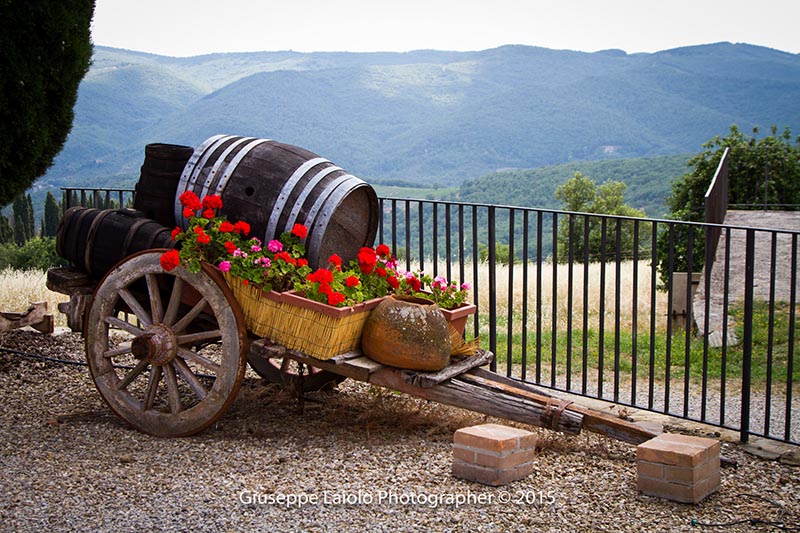
Castelvecchi: the village that preserves a thousand years of Chianti
Amid the rolling hills of Chianti, where Tuscany reveals itself in its purest form, lies Castelvecchi, a tiny village encompassing a millennium of history, wine, and landscape.
Located a few kilometers from Radda in Chianti, this ancient medieval settlement is a place where time seems to have stood still, suspended between the stones of the pietra serena houses, the rows of Sangiovese vines, and the scent of the forest.
A village born in the heart of the Middle Ages
Castelvecchi’s origins date back at least to the 11th century, when medieval documents mention a castle and curtis, a small fortified settlement with adjoining farmland.
Its strategic and panoramic position guaranteed control and defense of the nearby parish church of Santa Maria Novella, one of the oldest and most evocative in Chianti.
During the Middle Ages, the village was inhabited by farmers, artisans, and minor nobles who lived in the shadow of the towers and defensive walls. The community of Castelvecchi, though small, enjoyed an autonomous and prosperous existence, rooted in the cultivation of vines and olives: the same activities that still shape its landscape today.
From castle to wine: a tradition that has never been interrupted
Over the centuries, wars and famines have changed the face of Tuscany, but Castelvecchi has remained faithful to its agricultural vocation.
During the Renaissance and the modern era, the village passed from hand to hand between noble families and landowners, until, in the 19th century, it became one of the historic farms of Chianti Classico.
Its rebirth was passionately led by the Gutierrez de la Solana family, who brought to light the authentic soul of the village and its wine production.
Thanks to careful restoration and enhancement, Castelvecchi is now once again a vibrant place, where rural tradition meets quality and contemporary winemaking research.
The vineyards are located between 530 and 560 meters above sea level—among the highest in Chianti—and are rooted in ancient soils of marl and sandstone.
The result is elegant and complex wines, such as the Chianti Classico Capotondo, the Riserva Lodolaio, and the Gran Selezione Madonnino della Pieve, each with its own history and voice.
Visiting the winery means entering a world suspended between past and present: oak barrels nestled beneath stone vaults, the scent of must, and silence interrupted only by the dripping of the wine as it rests.
Walking among stones and panoramas
The village of Castelvecchi, now beautifully restored, is a small treasure trove of rural Tuscan architecture.
Walking along its cobbled streets, you’ll encounter ancient stone houses, a chapel, an olive oil mill now converted into an exhibition space, and views that suddenly open up over the Chianti valleys.
From the village’s natural terrace, the view sweeps across vineyards and rolling hills that resemble waves.
Each season offers a different facet: the tender green of spring, the golden summer harvest, the red of autumn vines, and the blue silence of winter.
For those who love photography or simply walking, Castelvecchi is an ideal place to discover authentic Tuscany, far from the crowds yet rich in authenticity and discreet beauty.
Castelvecchi Today: An Experience to Live
Today, Castelvecchi is not only a visitable village, but also a place to live.
The historic buildings house Tuscan-style rooms and apartments, ideal for those seeking a peaceful stay amidst the countryside.
The panoramic swimming pool overlooks the vineyards, while the restaurant offers typical Chianti dishes—soups, grilled meats, cheeses, and local wines—often served outdoors, under the starry Chianti sky.
Throughout the year, the farm organizes guided tastings, cellar tours, cooking classes, and even weddings and ceremonies in the medieval setting of the village.
It’s the perfect place for those seeking a slow vacation, filled with authentic experiences, countryside scents, and sunsets that seem like paintings.
The charm of time gone by
Castelvecchi is not a museum, but a living place: a microcosm where history, nature, and wine meet in perfect balance.
Those who come here find not just a castle or a farm, but an intact fragment of Tuscany, where time has learned to move slowly.
And when you leave the village, after toasting with a glass of Chianti Classico from the Gutierrez de la Solana family, you have the feeling that something has remained within: the silence of the stones, the scent of must, the quiet beauty of a landscape that has told the same story for a thousand years.


